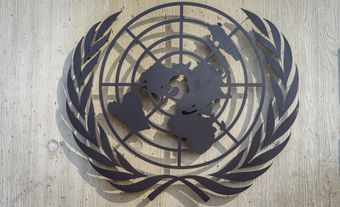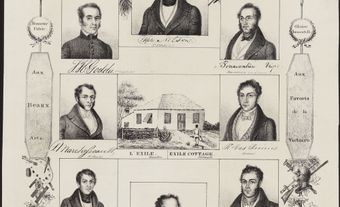This article was originally published in Maclean’s magazine on August 5, 1996. Partner content is not updated.
One soggy day late last April, Art Poirier found himself among thousands of people stacking sandbags against rising floodwaters from southern Manitoba's ancient and implacable nemesis, the Red River. Poirier flicked a cigarette butt into the brand new lake around his home.Saguenay Floods Kill 10
One soggy day late last April, Art Poirier found himself among thousands of people stacking sandbags against rising floodwaters from southern Manitoba's ancient and implacable nemesis, the Red River. Poirier flicked a cigarette butt into the brand new lake around his home. The river, he conceded, was "hard to contain once it gets peeved at you." But the Red was not mad at Art - they were both victims. The peevishness belonged to the weather that for months has been on a bruising rampage across Canada. So far this year, exhibiting the mercurial moods of a full-blown psychotic, it has at one time or another frozen, soaked, battered, marooned or frightened much of the country. Tornadoes explode barns, hailstones smash greenhouses and windshields, and heavy rains turn fields into inland seas. "We're getting a little weary waiting for something normal to happen," says climatologist David Phillips of Environment Canada, "but normal is what you rarely get in Canada."
While almost no part of the nation escaped one of the longest and most vicious winters in recent years - several cities had spent their snow-removal budgets by Christmas - the sodden aftermath did the real damage. In Quebec, where 10 people perished in torrential flooding in the Saguenay river system 250 km north of Quebec City, civil defence authorities pegged the damage at $450 million. Others said that given the impact on big companies like Abitibi-Price, $500 million was more realistic. More than 12,000 people were driven, boated or airlifted to safety from swollen rivers and mud slides.
The devastation in Quebec revived memories of Hurricane Hazel's lethal assault on the Toronto region in 1954, when more than seven inches of rain fell in 24 hours (compared with up to eight inches in 48 hours in the Saguenay region) and 81 people died. The disaster in Quebec was also a reminder that the weather's wrath had played out elsewhere in the country - if less damagingly - for months.
In late April, a pair of tornadoes smashed through south-central Ontario, exploding houses and barns, collapsing hydro lines, killing livestock and seriously injuring two people. The damage ranged between $5 million and $8 million. A month later, Southwestern Ontario got the full treatment: floods, severe thunderstorms and tornadoes - between 80 and 100 are reported in Canada every year - that tossed tractor trailers off the highway. Dave Wilsher of St. Catharines was on his way to see Twister at a drive-in movie when a real-life one "just hit like a wall" and destroyed the screen.
But weather's greatest savagery this year has been visited on rural Quebec and southern Manitoba where floods, fed by melting ice and spring rains, are a menace older than living memory. This time, they covered 400 square miles of farmland, forced the removal of 100 families from homes along the rising Red and marooned livestock. Thousands of army reservists and civilian volunteers reinforced dikes. It was distressing - but a far cry from 1950 when the raging Red forced the evacuation of about one-third of Winnipeg's population and caused $100 million in damage.
As spring gave way to early summer, northern Ontario - usually preoccupied with forest fires - repelled floodwaters threatening the communities of Chapleau, Timmins, Foleyet and White River. In mid-June, people in western Saskatchewan ran for cover from tornadoes, 160-km/h winds and hail as big as golf balls. The twisters blew roofs off, knocked down power lines and ripped the front door off a post office. Towards the end of June, a tornado touched down near Medicine Hat, Alta., and in mid-July, hail and thunderstorms trashed a trailer park outside Edmonton. "The rain was coming right up the lawn," marvelled Susan Sobottka. For the second time within two weeks, heavy rain took a swing at Calgary, doing more than $1-million damage to a car dealership and forcing Rockyview Hospital to postpone surgery when the drains backed up. And what has all that to do with the hottest topic in weather-watching circles - global warming? Scoffers point to last winter's deep freeze as evidence that there is no such thing. However, notes Environment Canada's Henry Hengeveld, one cold winter in one part of the world means little. The fact is, he says, average global temperatures are rising, and this year's weather extremes across Canada are consistent with the changes that climatologists foresee. "This is probably the most dramatic way in which climate change will affect people," he said.
Still, it is an ill wind that blows no good. And tornadoes, floods and mud slides draw viewers to Canada's eight-year-old cable-TV Weather Network, the first one of its kind in the world. Weather Network UK went on the air in Britain in June and Weather Network Italy will follow on Sept. 1. Five years ago, the Canadian network's commercial revenues were around $650,000. This year, with five bureaus across Canada, a staff of more than 200, including 20 meteorologists, revenue will reach $5 million. "The weather is one of the few things that unites this country, and for us it is always a breaking story," says Andy Peplowski, the network's manager of news services. "We're going to become the CNN of weather."
Maclean's August 5, 1996

 Share on Facebook
Share on Facebook Share on X
Share on X Share by Email
Share by Email Share on Google Classroom
Share on Google Classroom


